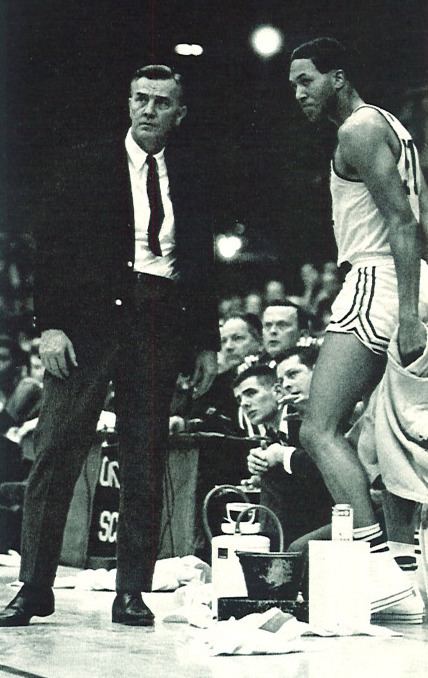Sport(s) Basketball Overall 657–382 (.632) | Name Ralph Miller Role Basketball Coach | |
 | ||
Born March 9, 1919Chanute, Kansas ( 1919-03-09 ) Died | ||
Ralph miller by patrick graybill
Ralph H. Miller (March 9, 1919 – May 15, 2001) was an American basketball coach. A native of Chanute, Kansas, Miller coached at the University of Wichita (1951–1964), the University of Iowa (1964–1970) and Oregon State University (1970–1989), compiling a 657-382 (.632) overall record in 38 seasons combined. He was enshrined to the Naismith Memorial Basketball Hall of Fame as a coach on May 3, 1988. His teams had losing records only three times.
Contents
- Ralph miller by patrick graybill
- On the green with ralph miller
- Early life
- University of Wichita
- University of Iowa
- Oregon State University
- Retirement
- Personal life
- Head coaching record
- References
On the green with ralph miller
Early life
Miller was a standout athlete in high school and college. At Chanute High School in Kansas, he won letters in football, track, basketball, golf and tennis. He was an all-state basketball player for three years.
In college at the University of Kansas, he won three letters as a football quarterback and three in basketball. He set the state record in the low hurdles in 1937. He was all-state three consecutive years in football and basketball. By 1940, he was beating the 1932 gold medalist in the decathlon Jim Baush in seven of 10 events.
As an undergraduate, he was coached by the legendary Phog Allen. In one of Miller's classes, a guest lecturer was Dr. James Naismith, the inventor of basketball. Miller was also a member of Phi Kappa Psi Fraternity at KU.
After he earned a bachelor's degree in physical education in 1942, he spent three years in the Army Air Forces, leaving as a First Lieutenant.
Miller's first coaching position was at Mount Oread High School in Lawrence, and the team consisted primarily of professors' sons. The season did not go well and left a sour taste in his mouth towards coaching basketball.
Miller didn't have to go overseas during World War II because of knee problems that began at KU. He enlisted in the Air Force and held desk jobs in Florida, Texas and California. After the war, he became an assistant director of recreation and oversaw a swimming pool and playground in Redlands, California. Soon, he joined a friend in the business of hauling fruit.
In 1949, eight years after his ill-fated first attempt at coaching, a friend from Wichita, Kansas named Fritz Snodgrass sent Miller a telegram asking if he might be interested in returning to guide his son's team at East High School. At East, Miller became a student of the game. He was fascinated by the full-court press zone defense that had been developed at Kansas in 1930, but he wondered why it was only used after a basket was made. Nobody could give Miller a solid answer, and so he began tinkering with ways to press after missed shots, too. His idea was to assign each player a man to guard, and when an errant shot went up, they were immediately to pick up their man. His ideas were very successful. In three years at East High, Miller's teams finished second, third and first in the state using his system of execution and pressure basketball.
University of Wichita
In 1951, the president of the University of Wichita (now Wichita State University) offered him a job. Miller spent 13 years at Wichita, winning 220 games, earning three NIT berths and a spot in the NCAA Tournament in 1964.
University of Iowa
In the spring of 1964, Miller left for the University of Iowa of the Big Ten Conference, where he built one of the greatest offensive juggernauts in NCAA history. The Hawkeyes averaged more than 100 points a game in Big Ten play in 1970 and went undefeated in the Big Ten en route to an NCAA Tournament berth.
Oregon State University
In 1970, Miller was offered the job at Oregon State after Paul Valenti stepped down. Miller had only two losing seasons in 19 years at OSU. He retired as the second all-time winningest coach in Oregon State history with 359 victories.
Retirement
Miller retired at age 70 in 1989, with a record of 657–382 (.632). The 657 victories were the most by an active coach and ranked him seventh among major-college coaches, trailing only Adolph Rupp (876), Hank Iba (767), Ed Diddle (759), Phog Allen (746), Ray Meyer (724), and John Wooden (664). Miller's teams actually won 674 games, but the total was reduced by forfeits because one of his players, Lonnie Shelton, had signed with an agent while still in college in 1976.
The floor of Gill Coliseum, Oregon State's basketball arena, is named Ralph Miller Court. The street in front of Gill Coliseum was renamed Ralph Miller Drive shortly upon his retirement.
Personal life
In the fall of 1937, while at the University of Kansas, he took a physiology class, and the students were seated alphabetically. Next to him was an attractive co-ed from Topeka named Emily Jean Milam; five years later they were married. The couple had two sons, Ralph Jr. and Paul, and two daughters, Susan Langer and Shannon Jakosky.
The gymnasium at Chanute High School is named after Ralph Miller, and is home to the Ralph Miller Classic, an eight-team tournament.
Miller had an unequaled addiction to cigarettes, and chain-smoked More brand cigarettes during practices, on team buses and in his office.
Head coaching record
* 15 wins were forfeited and official record for that season is 3-24
** 1 NCAA Tournament loss was vacated
*** 2 NCAA Tournament wins and 1 loss were vacated
**** Official Record with vacated and forfeited wins and losses
